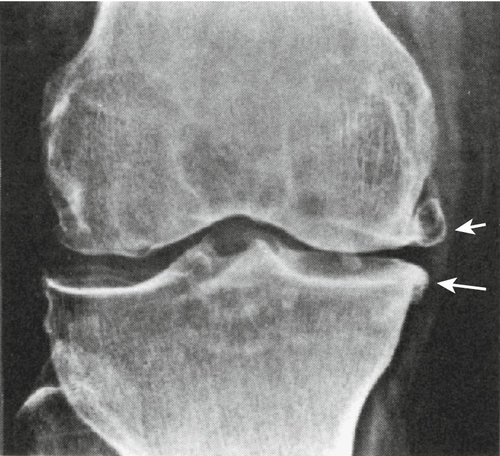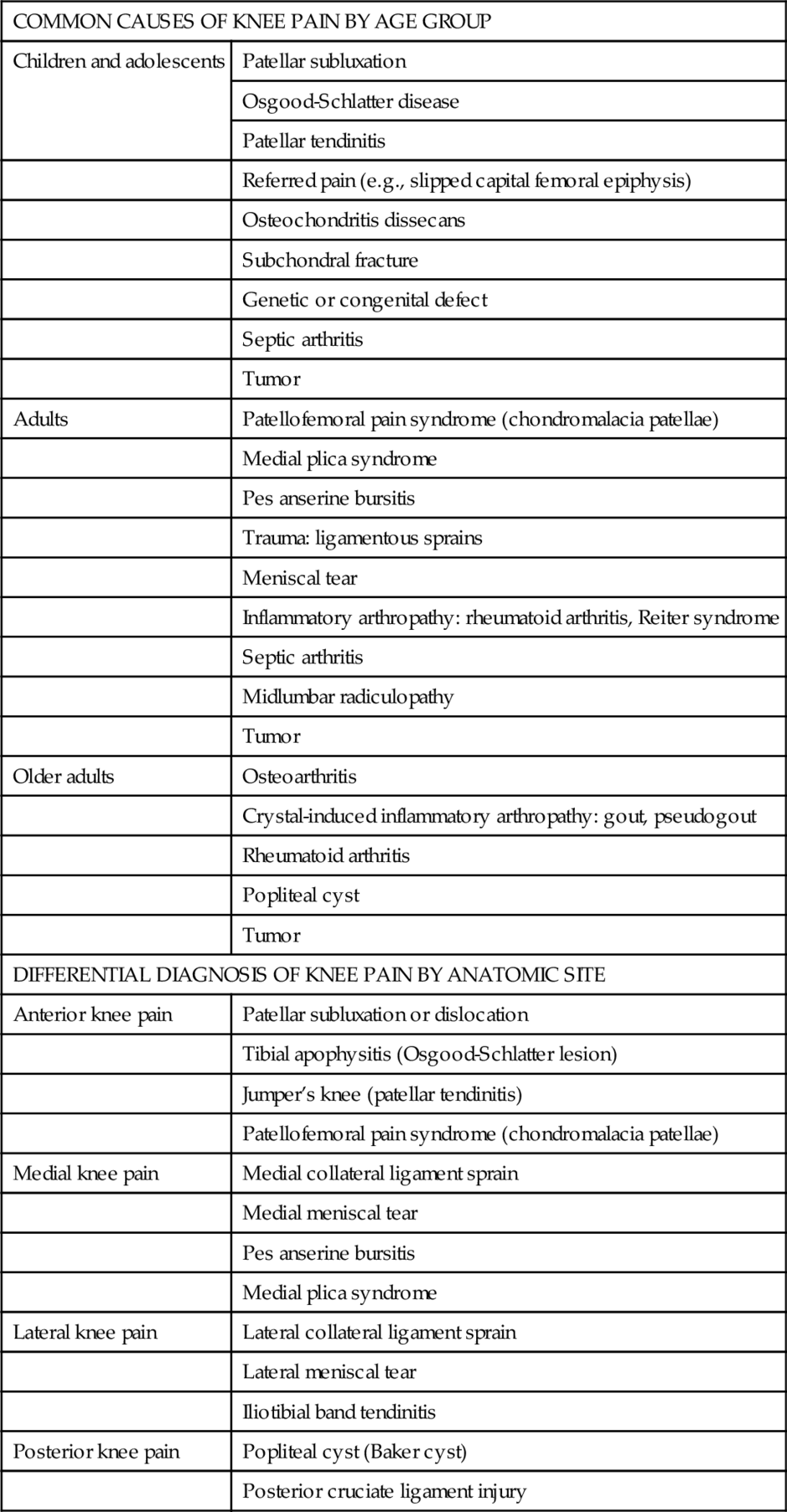CHAPTER 70
Knee Osteoarthritis
Michael Sein, MD; Allen N. Wilkins, MD; Edward M. Phillips, MD
Definition
Osteoarthritis is steadily becoming the most common cause of disability for the middle-aged and has become the most common cause of disability for those older than 65 years [1]. The knee joint is the most common site for lower extremity osteoarthritis [2]. It is estimated that nearly half of all adults will have symptomatic knee osteoarthritis in their lifetimes [3]. In addition to the growing population of elderly patients with knee osteoarthritis, an increasing number of former athletes with previous knee injuries may experience post-traumatic knee osteoarthritis. Osteoarthritis of the knee results from mechanical and idiopathic factors. Osteoarthritis alters the balance between degradation and synthesis of articular cartilage and subchondral bone.
Osteoarthritis can involve any or all of the three major knee compartments: medial, patellofemoral, or lateral. The medial compartment is most often involved, leading to medial joint space collapse and thus to a genu varum (bowleg) deformity. Lateral compartment involvement may lead to a genu valgum (knock-knee) deformity. Isolated disease of the patellofemoral joint occurs in up to a quarter of patients with osteoarthritis of the knee [4]. Arthritis in one compartment may, through altered biomechanical stress patterns, eventually lead to involvement of another compartment.
Osteoarthritis affects all structures within and around a joint. Hyaline articular cartilage is lost. Bone remodeling occurs, with capsular stretching and weakness of periarticular muscles. Synovitis is present in some cases and ligamentous laxity occurs. Lesions in the bone marrow may also develop, which may suggest trauma to bone [5]. Osteoarthritis involves the joint in a nonuniform and focal manner. Localized areas of loss of cartilage can increase focal stress across the joint, leading to further cartilage loss. With a large enough area of cartilage loss or with bone remodeling, the joint becomes tilted, and malalignment develops.
The threat of knee osteoarthritis is not only a concern for elderly populations. Malalignment is the most potent risk factor for structural deterioration of the knee joint [6]. By further increasing the degree of focal loading, malalignment creates a vicious circle of joint damage that ultimately can lead to joint failure. The role of obesity as a risk factor for knee osteoarthritis has been well documented. A large, population-based prospective study found that the risk for knee osteoarthritis was seven times greater for people with a body mass index of 30 or higher compared with those with a body mass index below 25 [7]. Moreover, women (of average height) who lost 5 kg of weight reduced their risk of symptomatic knee osteoarthritis by 50% [8].
Sports injuries and vigorous physical activity are considered to be important risk factors in knee osteoarthritis. Elite athletes who take part in high-impact sports, such as soccer and ice hockey, have an increased risk of knee osteoarthritis [9]. It is unclear whether the increased risk in this particular study was directly related to traumatic injury. However, it has been suggested in another study that subjects with a history of knee injury are at a fivefold to sixfold increased risk for development of knee osteoarthritis [10]. Knee osteoarthritis is common in those performing heavy physical work, especially if this involves knee bending, squatting, kneeling, or repetitive use of joints [11]. It is unclear if the association of knee osteoarthritis with these work-related activities is secondary to the nature of the work or the increased likelihood of injury.
Symptoms
Knee osteoarthritis is characterized by joint pain, tenderness, decreased range of motion, crepitus, occasional effusion, and often inflammation of varying degrees. Initial osteoarthritis symptoms are generally minimal, given the gradual and insidious onset of the condition. Pain typically occurs around the knee, particularly during weight bearing, and decreases with rest. With progression of the disease, pain can persist even at rest. Activities associated with osteoarthritic pain are climbing stairs, getting out of a chair, getting in and out of a car, and walking long distances. Pain may also radiate to adjacent sites as osteoarthritis indirectly alters the biomechanics of other anatomic structures, such as ligaments, muscles, nerves, and veins.
Joint stiffness may occur after periods of inactivity, such as after awakening in the morning or prolonged sitting. Patients often report higher pain levels in the morning but usually for less than 30 minutes. Patients often experience limitation of movement because of joint stiffness or swelling. Many patients report a “locking” or a “catching” sensation, which is probably due to a variety of causes, including debris from degenerated cartilage or meniscus in the joint, increased adhesiveness of the relatively rough articular surfaces, muscle weakness, and even tissue inflammation. Stiffness can discourage mobility. This initiates a cycle that results in deconditioning, decreased function, and increased pain.
Barometric changes, such as those associated with damp, rainy weather, will often increase pain intensity. Patients often note that their knees “give way” or feel unstable at times.
Physical Examination
Examination of the patient includes testing for various possible causes of knee pain (see section on differential diagnosis). Therefore the entire limb, from the hip to the ankle, is examined. It is important to identify findings such as quadriceps weakness or atrophy and knee and hip flexion contractures. Gait should be observed for presence of a limp, functional limb length discrepancy, or buckling. Genu varum or valgum is often better appreciated when the patient is standing.
The affected knee should be compared with the contralateral uninvolved knee. Knee examination may reveal decreased knee extension or flexion secondary to effusion or osteophytes (both of which may be palpable). Osteophytes along the femoral condyles may be palpated, especially along the medial distal femur. Palpation may reveal patellar or parapatellar tenderness. Crepitation, resulting from juxtaposition of roughened cartilage surfaces, may be appreciated along the joint line when the knee is flexed or extended. A mild effusion and tenderness may be appreciated along the medial joint line or at the pes anserine bursa. Ligament testing may reveal laxity of one or both of the collateral ligaments. Lateral subluxation of the patella may be found in patients with genu valgum (Table 70.1). Another clue on examination that the patient probably has knee osteoarthritis is the finding of visible bone enlargements (exostoses) of the fingers. At the distal interphalangeal joints, these are referred to as Heberden nodes; at the proximal interphalangeal joints, they are known as Bouchard nodes, usually a slightly later finding.
Table 70.1
Typical Physical Examination Findings in Knee Osteoarthritis
| Inspection | Bone hypertrophy Varus deformity from preferential medial compartment involvement |
| Palpation | Increased warmth Joint effusion Joint line tenderness |
| Range of motion | Painful knee flexion Decreased joint flexion secondary to pain Crepitus (coarse) |
| Joint stability | Mediolateral instability |
The findings of the neurologic examination are typically normal, with the exception of decreased muscle strength, particularly in the quadriceps, due to disuse or guarding secondary to pain.
Diagnostic Studies
Osteoarthritis is diagnosed clinically on the basis of history and physical examination. Imaging, however, can be used to confirm the diagnosis and to rule out other conditions. Radiographic abnormalities can be found both in joint areas subjected to excessive pressure and in joint areas subjected to diminished pressure. These changes include joint space narrowing, subchondral sclerosis, and bone cysts in weight-bearing regions of the joint and osteophytes in low-pressure areas, especially along the marginal regions of the joint. Joint space narrowing is the initial finding, followed by subchondral sclerosis, then by osteophytes, and finally by cysts with sclerotic margins (known as synovial cysts, subchondral cysts, subarticular pseudocysts, or necrotic pseudocysts).
Radiographic evidence of osteoarthritis is not well correlated with symptoms [12]. Results have been conflicting, probably because of the differences in populations studied and radiographic and clinical criteria used. The presence of osteophytes had a strong association with knee pain, whereas the absence or presence of joint space narrowing was not associated with pain [13].
Knee pain severity was a more important determinant of functional impairment than radiographic severity of osteoarthritis [14,15]. There was no correlation between joint space narrowing and a disability score (Western Ontario and McMaster Universities Osteoarthritis index, WOMAC) at a single time point [15].
Osteophytes alone are associated with aging rather than with osteoarthritis. Indications for plain x-ray films include trauma, effusion, symptoms not readily explainable by physical examination findings, severe pain, presurgical planning, and failure of conservative management. Recommended films are weight-bearing (standing) anteroposterior, lateral, and patellar views. Radiographs taken during weight bearing with the knee in full extension and partial flexion may reveal a constellation of findings associated with osteoarthritis, including asymmetric narrowing of the joint space (typically medial compartment), osteophytes, sclerosis, and subchondral cysts (Fig. 70.1). A Merchant view specifically evaluates the patellofemoral space. Non–weight-bearing lateral views may help in the evaluation of the patellofemoral and tibiofemoral joint spaces. Tunnel views can help visualize loose osteochondral bodies.

Magnetic resonance imaging usually adds little but cost to the entire evaluation of osteoarthritis of the knee. It may reveal changes that suggest the presence of osteoarthritis. However, it is not indicated in the initial evaluation of older persons with chronic knee pain. Magnetic resonance imaging may detect incidental findings, such as meniscal tears, that are common in middle-aged and older adults with and without knee pain. Musculoskeletal ultrasonography has potential for detecting bone erosions, synovitis, tendon disease, and enthesopathy. It has a number of distinct advantages over magnetic resonance imaging, including good patient tolerability and ability to scan multiple joints in a short time. However, there are scarce data about its validity, reproducibility, and responsiveness to change, making interpretation and comparison of studies difficult. In particular, there are limited data describing standardized scanning methodology and standardized definitions of ultrasound pathologic changes [16].
Laboratory test results are typically normal, but analysis may be undertaken, especially for elderly patients, to establish a baseline (e.g., blood urea nitrogen concentration, creatinine concentration, or liver function tests before use of nonsteroidal anti-inflammatory drugs or acetaminophen) or to exclude other conditions such as rheumatoid arthritis. Synovial fluid analysis should not be undertaken unless destructive, crystalline, or septic arthritis is suspected.
Treatment
Initial
The PRICE regimen may help provide initial relief for patients in pain: protection with limited weight bearing by use of a cane or modification of exercise to reduce stress; relative rest (or taking adequate rests throughout the day, avoiding prolonged standing, climbing of stairs, kneeling, deep knee bending); ice (applied while the skin is protected with a towel for up to 15 minutes at a time several times a day; note, however, that some patients with chronic pain may find better relief with moist heat); compression (if swelling exists, wrapping with an elastic bandage or a sleeve may help); and elevation (may help diminish swelling, if it is present). There are a wide variety of initial treatment options for knee arthritis. Current guidelines put forth by the American College of Rheumatology emphasize the use of acetaminophen as a first-line therapy for osteoarthritis [17








